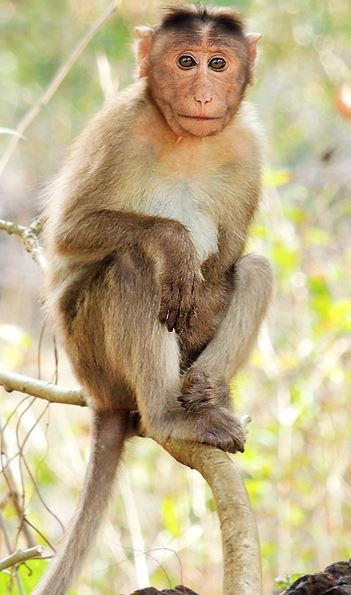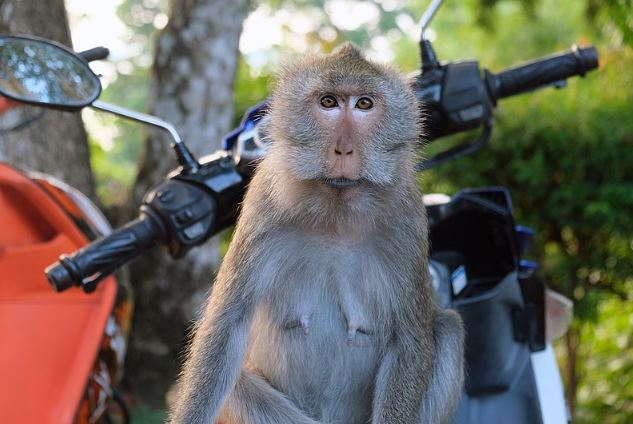There are many different species of primates in Thailand, but the macaque, a small, gray, or gray-brown monkey that typically resides in trees or other vegetation, is the one you’ll most likely see while there. Although the typical Thai macaque stands two feet tall and weighs 15 pounds, this does not mean that they cannot cause harm to you. Thailand’s macaques can be quite aggressive; each year, hospital visits for injuries caused by these primates are reported. You should decide if you still want to travel to Thailand. The government has even posted signs warning people to be cautious, but incidents still happen.
It’s crucial to be ready for interactions with these primates if you’re visiting Thailand because they are especially prevalent in tourist areas and improper interactions could result in serious injury or even theft. So, a backpacker needs to know tips that will help to stay safe in Thailand.
Monkeys in Thailand
Most likely because they resemble us in some way, monkeys are loved by many of us. These primates are renowned for their intelligence and curiosities as well as their propensity to engage in all manner of mischief. Does this sound familiar? The hills surrounding Hope Rehab are home to monkeys, and during your stay with us, you’ll probably have the chance to get close to these cheeky scamps.
In Thailand, there are five different species of monkeys:
- The Stump-tailed macaque
- The Pig-tailed macaque – is found mostly in South Thailand
- Crab-eating macaque or long-tailed macaque
- The Assam macaque
- The Rhesus macaque
During your stay with us here at Hope Rehab, the crab-eating macaque is something you’re most likely to see. Its name comes from the fact that this species can swim in the sea and that it can occasionally be seen scavenging for food on beaches in South-East Asia. The crab-eating monkey may become dependent on begging or food theft if it dwells close to populated areas. This species is referred to in Thai as “ling Seam,” where “ling” is the general term for “monkey”.
The belly of the crab-eating macaque is a lighter shade of gray than the rest of its fur, which ranges in color from light grey to brown. Its tail should be about the same length as its body if you were to measure it. Although you will find swarms of these monkeys living in Thai cities like Lopburi, they are most commonly seen living in tropical forests.
Thailand’s Primates: Terrestrial And Arboreal Mammals
1. Gibbon in Kaeng Krachan National Park
A relative of the orangutan ape lived in the dense jungles of what is now north and northeast Thailand during the Miocene Epoch (5.3-23.8 million years ago). Some truly amazing fossils have been discovered by scientists working in sandpits and coal mines. There have also been discoveries of other primates in the Kingdom, including a 13-million-year-old tarsier and an early Adapiform primate. Siamopithecus eocaenus, also known as the “Siam Ape,” is the oldest anthropoid known from fossils. It was discovered in strata that are 40 million years old in the southern Thai province of Krabi. Another piece of Thailand’s incredible natural heritage is this legacy.
2. Pig-tailed Macaque in Khao Yai National Park
Paleontologist Dr. Yaowalak Chaimanee of the Department of Mineral Resources made a crucial discovery in a lignite mine close to Chiang Muan district in the northern province of Phayao in 2003. Teeth from a hominid primate that lived between 10 and 13.5 million years ago have been discovered. The primate, which is related to orangutans, was first given the name Lufengpithecus chiangmuanensis. It was recently reclassified and given the new name Khoratpithecus chiangmuanensis due to yet another incredible discovery.
On the Khorat Plateau in the province of Nakhon Ratchasima, a new species of fossil orangutan about 7-9 million years old was dramatically discovered in 2004. Thailand was once more located on the global paleontological map. After Piriya Vachajitpan, who played a significant part in the discovery at the Tha Chang sandpits in the Chalerm Phrakiat district, the new ape was given the name Khoratpithecus biriyani (ape from Khorat). Like a living ape and humans, the lower jawbone and teeth have a U-shaped dental arcade.
3. Crab-eating Macaque in Sai Yok National Park
From 2 million to 100,000 years ago, during the Pleistocene era, orangutans lived in their modern form. Their geographic range used to include a large portion of Southeast Asia. However, due to hunting and deforestation, they went extinct in many areas. Only Borneo and Sumatra are home to orangutans today. The only great ape with a fossil history is the orangutan. Strangely, no chimpanzee or gorilla-related fossils from Africa have ever been discovered. However, tracing the orangutan’s ancestry has proven to be incredibly challenging.
4. Dusky Langur in Kaeng Krachan
Dr. Yaowalak has also found other primates, including the ancient primate Siamoadapis maemohensis. There has also been the discovery of a brand-new species, Tarsius sirindhornae, which lived about 13 million years ago. Tarsiers are primates, descended from the same ancestor as humans and monkeys.
Over 50 million years ago, during the Eocene epoch of accelerated mammalian evolution, primates began to evolve. According to a recent study, the oldest known primate in North America is a newly discovered species that is so small it can fit in the palm of your hand. On the Gulf Coastal Plain of Mississippi, paleontologist Christopher Beard of Pittsburgh, Pennsylvania’s Carnegie Museum of Natural History, recently discovered fossils of the 55-million-year-old creature.
5. Slow Loris in Kaeng Krachan
The oldest primate ever found Teilhardina magnolia is related to other fossils of a similar age found in China, Europe, and Wyoming’s Big Horn Basin. They are extremely primitive cousins of the tarsiers, living primates, found in Southeast Asia today. In the Big Bend region of West Texas, a new species of primate that lived 43 million years ago has been discovered. It was one of the last primates endemic to North America and was known by the name Mescalerolemur horneri. This tiny animal, which weighs only 370 grams, is related to the only lemurs that can be found today in Madagascar.
Be Cautious With Baby Macaques
Of all the primates found in Thailand, baby macaques are by far the cutest. However, even though these young monkeys may seem friendly and non-aggressive, handling them poses several dangers. These primates fiercely guard their young. A young monkey should not be approached or touched, and a mother monkey should not be approached while her young is being nursed. Being highly social animals, macaques will defend one another if they perceive a threat to a member of their pack.
Tourists frequently try to approach the younger animals first because they are less wary, and aggressive and appear to be friendlier than their older counterparts. However, if an older monkey perceives that you are endangering one of the young, the entire pack may attack.


